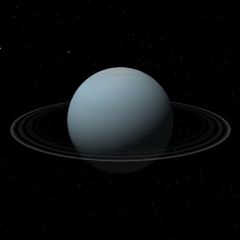Difference between revisions of "Uranus"
(Corrected link.) |
(Updated data and content.) |
||
| Line 12: | Line 12: | ||
|Name||align="right"|Uranus | |Name||align="right"|Uranus | ||
|- | |- | ||
| − | |width="30%"|Reference body||align="right" width="30%"|Sun | + | |width="30%"|Reference body||align="right" width="30%"|[[Sun]] |
|- | |- | ||
|width="30%"|Number of satellites||align="right" width="30%"| | |width="30%"|Number of satellites||align="right" width="30%"| | ||
| Line 20: | Line 20: | ||
|width="30%"|Epoch||align="right" width="50%"|J2000 (1 January 2000) | |width="30%"|Epoch||align="right" width="50%"|J2000 (1 January 2000) | ||
|- | |- | ||
| − | |width="30%"|Semimajor axis (a)||align="right" width="50%"| | + | |width="30%"|Semimajor axis (a)||align="right" width="50%"|2.87097222×10<sup>12 m (19.19126393 AU) |
|- | |- | ||
|width="30%"|Eccentricity (e)||align="right" width="30%"|0.04716771 | |width="30%"|Eccentricity (e)||align="right" width="30%"|0.04716771 | ||
|- | |- | ||
| − | |width="30%"|Inclination (i)||align="right" width="30%"|0.76986° <br> (0. | + | |width="30%"|Inclination (i)||align="right" width="30%"|0.76986° <br> (0.01343659 radian) |
|- | |- | ||
| − | |width="30%"|Longitude of the ascending node (LAN, ☊)||align="right" width="30%"|74.22988° <br> (1. | + | |width="30%"|Longitude of the ascending node (LAN, ☊)||align="right" width="30%"|74.22988° <br> (1.295558 radian) |
|- | |- | ||
|width="30%"|Longitude of periapsis (ϖ)||align="right" width="30%"|170.96424° <br> (2.983889 radian) | |width="30%"|Longitude of periapsis (ϖ)||align="right" width="30%"|170.96424° <br> (2.983889 radian) | ||
|- | |- | ||
| − | |width="30%"|Mean longitude (L)||align="right" width="30%"|313.23218° <br> (5. | + | |width="30%"|Mean longitude (L)||align="right" width="30%"|313.23218° <br> (5.4669329 radian) |
|- | |- | ||
!bgcolor="lightsteelblue" colspan="2"|Planetary orbital element centennial rates | !bgcolor="lightsteelblue" colspan="2"|Planetary orbital element centennial rates | ||
| Line 93: | Line 93: | ||
|} | |} | ||
| + | '''Uranus''' is the 7th planet from the [[Sun]], the third largest in diameter, and the fourth largest in mass. The planet boasts a ring system and 28 known satellites. [[w:William Herschel|William Herschel]] discovered Uranus on 13 March 1781, although he thought it was a comet for some time. Later, it was realized that it was observed several times by others, but, not recognized as a planet. It is just barely visible in a dark sky. Uranus is unique in that the polar axis is tilted some 97° to it's orbit. | ||
| − | + | == Uranus in Orbiter == | |
| − | + | Uranus has been a part of [[Orbiter]] since the beginning with the release of Orbiter 2016. | |
| − | |||
| − | |||
| − | |||
| − | |||
| − | |||
| − | |||
| − | |||
| − | |||
| − | |||
| − | |||
| − | |||
| − | |||
| − | |||
| − | |||
| − | |||
| + | == See also == | ||
| + | [[w:Uranus|Uranus]] at [[w:Wikipedia|Wikipedia]] | ||
{{UranusSat}} | {{UranusSat}} | ||
Revision as of 11:20, 20 July 2024
 | This article, about a planet, is a stub. You can help Orbiterwiki by expanding it.
Uranus is the 7th planet from the Sun, the third largest in diameter, and the fourth largest in mass. The planet boasts a ring system and 28 known satellites. William Herschel discovered Uranus on 13 March 1781, although he thought it was a comet for some time. Later, it was realized that it was observed several times by others, but, not recognized as a planet. It is just barely visible in a dark sky. Uranus is unique in that the polar axis is tilted some 97° to it's orbit. Uranus in OrbiterUranus has been a part of Orbiter since the beginning with the release of Orbiter 2016. See also:
| |||||||||||||||||||||||||||||||||||||||||||||||||||||||||||||||||||||||||||||||||||||||||||||||||||||||
